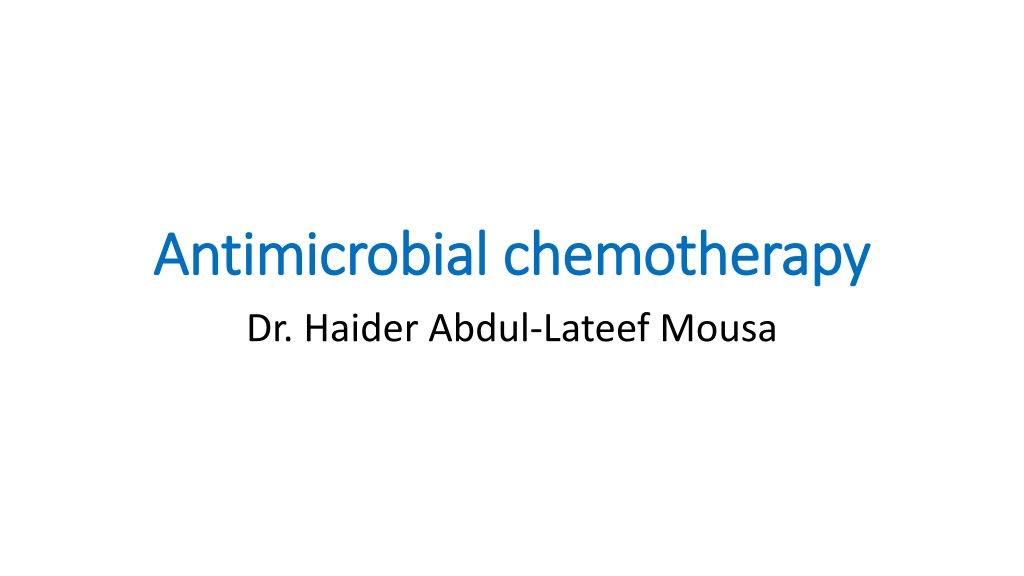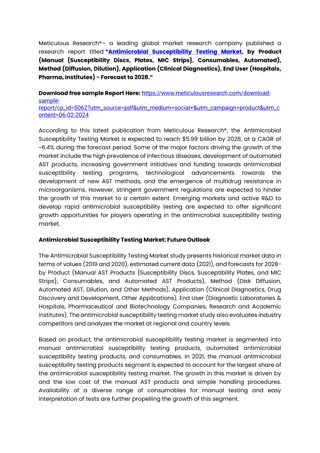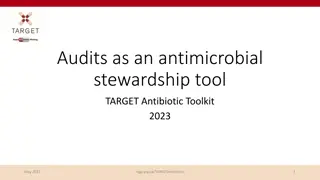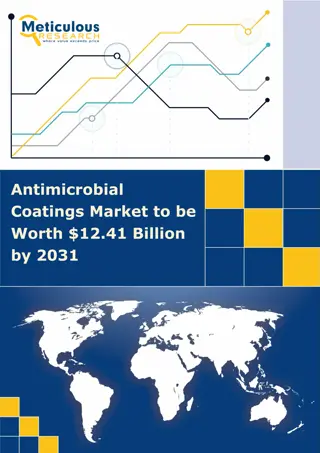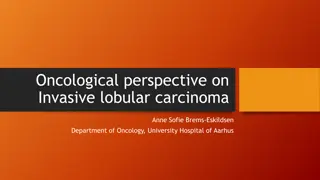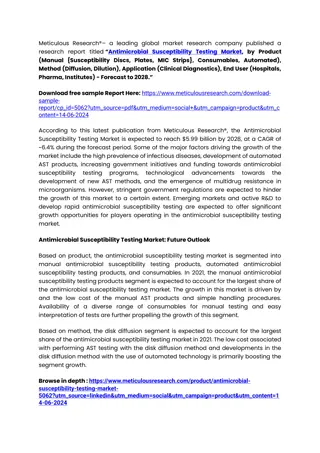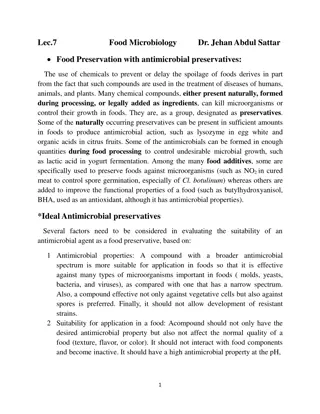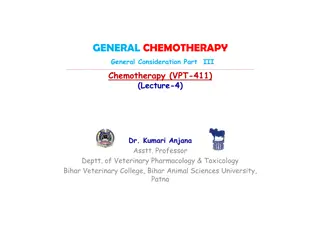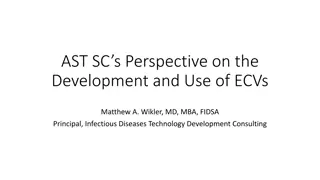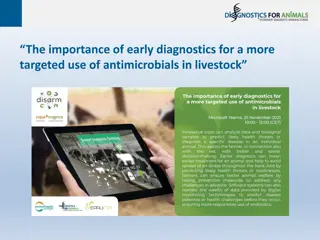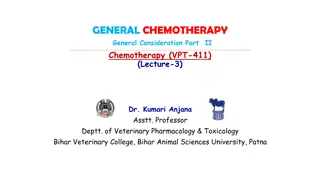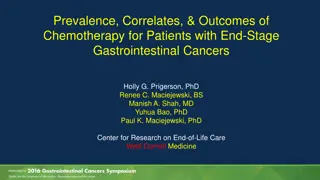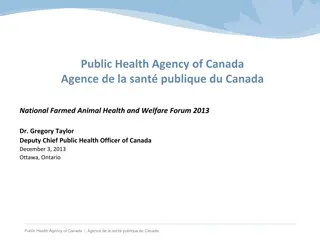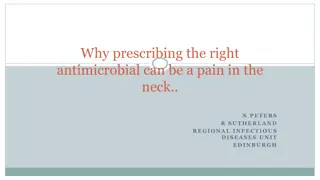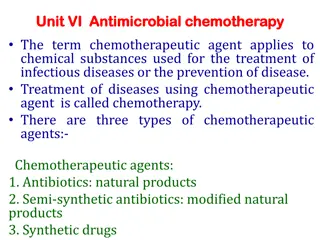Antimicrobial chemotherapy
Antimicrobial chemotherapy encompasses the clinical application of antimicrobial agents to combat infectious diseases, with antibiotic drugs targeting bacterial infections and antifungal, anthelminthic, antiprotozoal, and antiviral drugs tackling other types of infections. This field also involves understanding drug resistance mechanisms in bacteria and the detection of resistant organisms in clinical settings. Explore the terminology, features, and actions of antimicrobial drugs to better grasp their applications and impact. Gain insights into the varied susceptibility of microbes to different antibiotics and the key characteristics that influence the effectiveness and safety of antimicrobial therapy.
Download Presentation

Please find below an Image/Link to download the presentation.
The content on the website is provided AS IS for your information and personal use only. It may not be sold, licensed, or shared on other websites without obtaining consent from the author.If you encounter any issues during the download, it is possible that the publisher has removed the file from their server.
You are allowed to download the files provided on this website for personal or commercial use, subject to the condition that they are used lawfully. All files are the property of their respective owners.
The content on the website is provided AS IS for your information and personal use only. It may not be sold, licensed, or shared on other websites without obtaining consent from the author.
E N D
Presentation Transcript
Antimicrobial chemotherapy Antimicrobial chemotherapy Dr. Haider Abdul-Lateef Mousa
Learning Objectives To understand how antibiotics work To review how drug resistance develops in bacteria T o summarize current status of antimicrobial resistance in selected bacteria To understand how resistant organisms are detected in the clinical laboratory
Antimicrobial chemotherapy is the clinical application of antimicrobial agents to treat infectious disease. There are five types of antimicrobial chemotherapy: 1. Antibacterial chemotherapy, the use of antibacterial drugs to treat bacterial infections 2. Antifungal chemotherapy, the use of antifungal drugs to treat fungal infections 3. Anthelminthic chemotherapy, the use of antihelminthic drugs to treat worm infections 4. Antiprotozoal chemotherapy, the use of antiprotozoal drugs to treat protozoan infections 5. Antiviral chemotherapy, the use of antiviral drugs to treat viral infections
Terminology Terminology Antimicrobial drugs - Interfere with the growth of microbes within a host. Antibiotic - Of biological origin. Produced by a microbe, inhibits other microbes (penicillin). Can be modified to enhance efficacy (semisynthetic). Chemotherapeutic agent - Synthetic chemicals (Sulfa drugs). Antiseptic An agent used to inhibit or eliminate microbes on skin or other living tissue (alcohol, iodine, chlorhexidine) Disinfectant An agent used to destroy microbes on inanimate objects (phenols, formaldehyde, chlorine)
The susceptibility of microbes to different antibiotics varies greatly Gram-positive and gram-negative bacteria vary in their sensitivity to antibiotics Broad-spectrum antibiotics are effective against both groups of bacteria
Features of Antimicrobial Drugs Selective toxicity: Drug kills pathogens without damaging the host. Therapeutic index: ratio between toxic dose and therapeutic dose High therapeutic index less toxic Antimicrobial action Bacteriostatic vs. bactericidal Activity Spectrum Broad-spectrum vs. narrow- spectrum Tissue distribution, metabolism, and excretion Unstable in acid; half-life duration
Classification of Antibiotics by Mechanism of Action Inhibition of cell wall synthesis Beta-lactam drugs Penicillins Cephalosporins Carbapenems The others Cycloserine Vancomycin bacitracin
Antibacterial mechanism of Antibacterial mechanism of - -lactams lactams
Disruption of cell membranes Polymyxin Polyenes (anti-fungal agents)
Inhibition of protein synthesis Reversible inhibition (bacteriostatic) Chloramphenicol The tetracyclines The macrolides (erythromycin) Clindamycin Streptogramins Linezolid Irreversible the bactericidal aminoglycosides
-Lactam Antibiotics: Penicillins and Cephalosporins -Lactam antibiotics are one of the most important groups of antibiotics of all time Include penicillins, cephalosporins, and cephamycins Over half of all antibiotics used worldwide Penicillins Discovered by Alexander Fleming in1928. Primarily effective against gram-positive bacteria Some synthetic forms are effective against some gram- negative bacteria Target cell wall synthesis Cephalosporins Produced by fungus Cephalosporium Same mode of action as the penicillins
Antibacterial Antibiotics Inhibitors of Cell Wall Synthesis: Penicillin Natural and semisynthetic penicilins contain -lactam ring Natural penicillins produced by Penicillium are effective against Gram + cocci and spirochetes Semisynthetic penicillins: made in laboratory by adding different side chains onto -lactam ring penicillinase resistant and broader spectrum of activity
Penicillinase (-lactamase): bacterial enzyme that destroys natural penicillins Penicillinase resistantpenicillins: methicilin replaced by oxacilin and nafcilin due to MRSA Extended-spectrum penicilins: Ampicilin, amoxicilin; new: carboxypenicilins and ureidopenicillins (also good against P. aeruginosa)
Cephalosporins Produced by Fungi of genus Cephalosporium Generations of cephalosporins. 1.First-generation: Narrow spectrum, gram-positive 4 2.Second-generation: Extended spectrum includes gram- negative 3.Third-generation: Includes pseudomonads; mostly injected, some oral. 4.Fourth-generation: Most extended spectrum
Cephalosporins cont. Structure and mode of action resembles penicilins 1.More stable to bacterial -lactamases than penicilins 2. Broader spectrum used against penicillin-resistant strains
Vancomycin Glycopeptide from Streptomyces Inhibition of cell wall synthesis Used to kill MRSA (Methicillin-resistant Staphylococcus aureus)
Antibiotics from Prokaryotes Many antibiotics effective against Bacteria are also produced by Bacteria Aminoglycosides are antibiotics that contain amino sugars bonded by glycosidic linkage Examples: Gentamicin, kanamycin, neomycin, amikacin Not commonly used today Neurotoxicity and nephrotoxicity Considered reserve antibiotics for when other antibiotics fail
Antibiotics from Prokaryotes, cont. Macrolides contain lactone rings bonded to sugars Example: erythromycin Broad-spectrum antibiotic that targets the 50S subunit of ribosome Tetracyclines contain four rings Widespread medical use in humans and animals Broad-spectrum inhibition of protein synthesis Inhibits functioning of 30S ribsomal subunit
Antifungal Drugs Antifungal Drugs Polyenes, such as nystatin and amphotericin B, for systemic fungal infections. Inhibition of ergosterol synthesis fungicidal. Nephrotoxic Griseofulvin from Penicillium. Systemic/oral. Binds to tubulin For Tineae
Antiviral Drugs Antiviral Drugs Nucleoside analogs inhibit DNA synthesis Acyclovir and newer derivatives: Selective inhibition of herpes virus replication. Acyclovir conversion to nucleotide analog only in virus infected cells very little harm to uninfected cells! Oseltamivir (Tamiflu) is an antiviral medication used to treat and prevent influenza A and influenza B. It is a neuraminidase inhibitor, a competitive inhibitor of influenza's neuraminidase enzyme. Paxlovid (nirmatrelvir tablets and ritonavir tablets), and molnupiravir used for the treatment of mild-to-moderate coronavirus disease (COVID-19).
Antiprotozoan and Antihelminthic Drugs Examples of Antiprotozoan: Chloroquine: Malaria Quinacrine: Giardia Metronidazole (Flagyl): Entamoeba histolytica, Vaginitis, anaerobic bacteria Examples of Antihelminthic: Niclosamide and praziquantel: Tapeworm Mebendazole: broadspectrum antihelmintic Ivermectin: nematodes, mites, lice . . .
Antibiotic Assays to Guide Chemotherapy Agar Disk Diffusion Method determines susceptibility of an organism to a series of antibiotics: Kirby-Bauer test Dilution Susceptibility Tests: Minimal inhibitory conc. ( MIC ) Lowest conc. of a drug that bacterial growth . Measurement of Drug Concentration in the Blood
